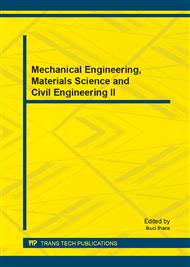[1]
Jywe WY, Liu CH and Chen CK. (1999). The min-max problem for evaluating the form error of a circle. Measurement, Vol. 26(4), pp.273-282.
DOI: 10.1016/s0263-2241(99)00052-4
Google Scholar
[2]
Wechenmann A, Eitzert H and Garmer M. (1995). Functionality oriented evaluation and sampling strategy in coordinate metrology. Precision Engineering, Vol. 17(4), pp.244-252.
DOI: 10.1016/0141-6359(94)00020-z
Google Scholar
[3]
Namboothiri VNN and Shunmugam MS. (1998). Function-oriented form evaluation of engineering surfaces. Precision Engineering, Vol. 22(2), pp.98-109.
DOI: 10.1016/s0141-6359(98)00002-6
Google Scholar
[4]
Lai J and Chen I. (1996). Minimum zone evaluation of circles and cylinders. International Journal of Machine Tools and Manufacture, Vol 36(4), pp.435-451.
DOI: 10.1016/0890-6955(95)00077-1
Google Scholar
[5]
Olivier D and Franco PP. (2003). Culling a set of points for roundness of cylindricity evaluations. International Journal of Computational Geometry, Vol. 13(2), pp.232-240.
DOI: 10.1142/s021819590300113x
Google Scholar
[6]
Li XM, Liu HQ and Li W. (2011). Development and application of α-hull and Voronoi diagrams in the assessment of roundness error. Measurement Science and Technology, 22: 045015.
DOI: 10.1088/0957-0233/22/4/045105
Google Scholar
[7]
Gadelmawla ES. (2010). Simple and efficient algorithms for roundess evaluation from the coordinate measurement data. Measurement , Vol. 43(2), pp.223-235.
DOI: 10.1016/j.measurement.2009.10.001
Google Scholar
[8]
Samuel GL and Shunmugam MS. (2000). Evaluation of circularity from coordinate and form data using computational geometric techniques. Precision Engineering, Vol. 24(3), pp.251-263.
DOI: 10.1016/s0141-6359(00)00039-8
Google Scholar
[9]
Lei XQ, Zhang CY, Xue YJ and Li JS. (2010). Roundness error evaluation algorithm based on polar coordinate transform. Measurement, Vol. 44(2), pp.345-350.
DOI: 10.1016/j.measurement.2010.10.007
Google Scholar
[10]
Li XM and Shi ZY. (2010). Evaluation of roundness error from coordinate data using curvature technique. Measurement, Vol. 43(2), pp.164-168.
DOI: 10.1016/j.measurement.2009.09.002
Google Scholar
[11]
Li XM and Liu HQ. (2012). A simple and efficient algorithm for evaluation of roundness error. Measurement Science and Technology, 23(8): 087003.
DOI: 10.1088/0957-0233/23/8/087003
Google Scholar
[12]
Lai HY, Jywe WY and Chen CK. (2000). Precision modeling of form errors for cylindricity evaluation using genetic algorithms. Precision Engineering, Vol. 24 (4), pp.310-319.
DOI: 10.1016/s0141-6359(00)00041-6
Google Scholar
[13]
Wen XL, Xia QG and Zhao YB. (2006). An effective genetic algorithm for circularity error unified evaluation. International Journal of Machine Tools and Manufacture, Vol. 46(14), pp.1770-1777.
DOI: 10.1016/j.ijmachtools.2005.11.015
Google Scholar
[14]
Chen M C, Tsai D M and Tseng H Y. (1999). A stochastic optimaztion approach for roundness measurements . Pattern Recognition Letters, 20: 707-719.
DOI: 10.1016/s0167-8655(99)00035-5
Google Scholar
[15]
Huang J. (2001). A new strategy for circularity problems. Precision Engineering, Vol. 25(4), pp.301-308.
Google Scholar


